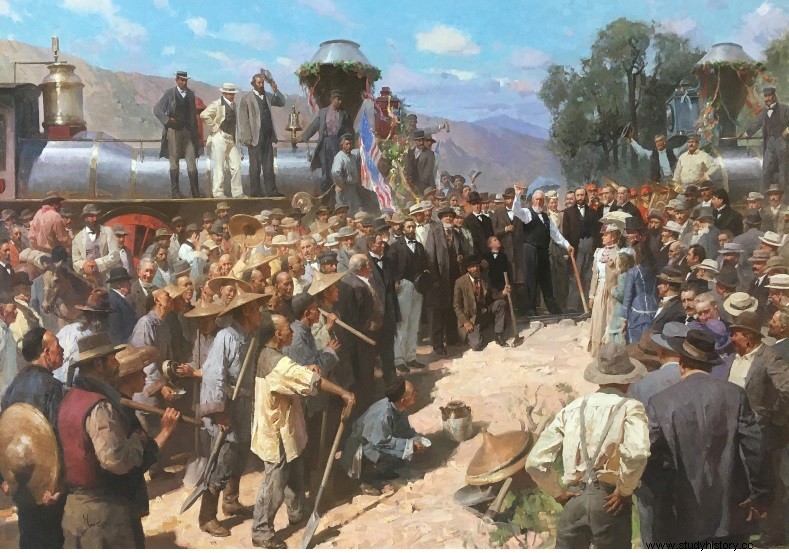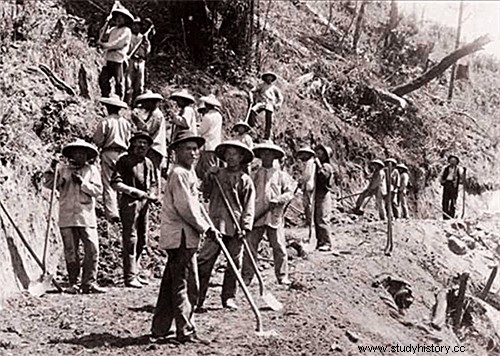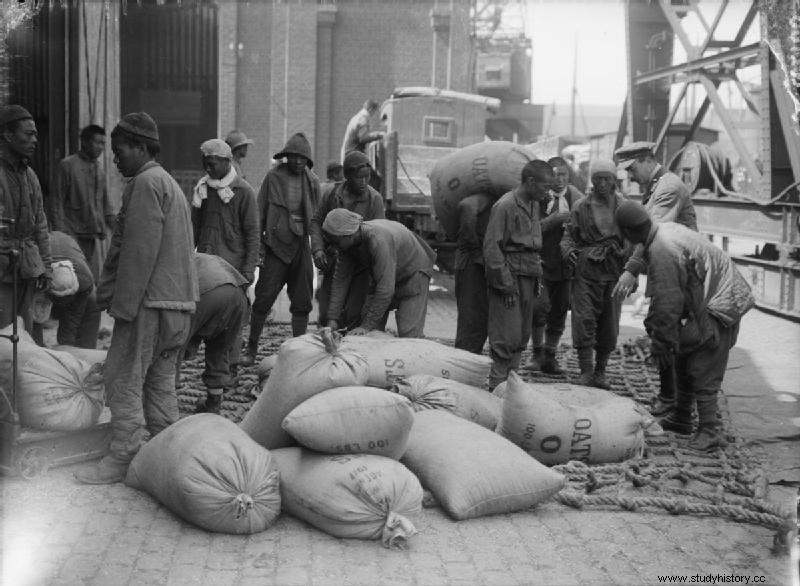In the mid-nineteenth century, the European population faced, perhaps for the first time, the omens of Malthus's theory, which came to say that food production would not increase in the same proportion as the population, which meant that, In fact, there would be serious short-term supply problems for basic products. The fields of the Old World were depleted after decades of overharvesting and erosion. It was the British, starting in the 1840s, who discovered the magnificent fertilizing properties of guano (seabird droppings) and at that time began the large-scale exploitation of such precious fertilizer from Peru. The "harvesting" of this fertilizer, rich in nitrogen, ammonia, phosphates and alkaline salts, was done almost exclusively in the Chincha Islands (Peru). This area of the Pacific is populated by producers of guano (gulls, pelicans...) which for years has been accumulating on the island's surface (several meters thick). Peru controlled the production and England its trade.

Chincha (Peru) – The guano islands
As expected, many other Pacific islands were also potential producers of the precious fertilizer. In 1856, to reduce costs and not rely on imports, the United States Congress passed the Guano Islands Act (Guan Islands Act), authorizing United States citizens to take possession of islands with guano deposits:
When any citizen of the United States discovers a deposit of guano on any island, rock, or cay, not within the lawful jurisdiction of any other government, and not occupied by citizens of any other government, and peacefully takes possession of, and occupies, whether island, rock, or cay, may, at the discretion of the president, be considered to belong to the United States.
More than one hundred guano deposits were claimed as American under this act. Today, several of these islands are still under US rule. The response of Peru and England was to increase the production of the Chincha Islands and try to monopolize the market. For this they needed to hire more labor... and cheap. Ships were sent to China where humble peasants were promised well-paying jobs in the gold mines. When they arrived in Peru, they were sent like cattle to the islands to work in the guano mines in precarious and dangerous conditions, typical of slavery that, let us remember, the British had abolished a few years ago (they invented labor slavery with zero rights and all obligations). In 1875 there were more than one hundred thousand Chinese in Peru. Due to the high mortality of Chinese workers (accidents, illnesses and even suicides) and the decrease in new remittances (news of false job offers began to reach China) they had to look for new sources of labor.

On May 10, 1869 the Central Pacific Railroad and the Union Pacific Railroad they were at Promontory Summit (Utah) making the dream of a great American transcontinental railroad come true, the largest engineering project of the time, crucial to developing the American West and connecting the United States in its entirety.
President Abraham Lincoln was able to see beyond the needs of a country at war (they were in the midst of the Civil War) and propose projects for the future, so on July 1, 1862 he signed the Pacific Railroad Act, committing federal resources to the ambitious plan to build a continuous rail line from the Atlantic to the Pacific. The contract was awarded to two companies:the Union Pacific, which would start in Omaha, Nebraska, and go west, and the Central Pacific, which would build from Sacramento, California, to the east. A mad race to get the largest number of kilometers of railway by the two companies involved in its construction. The result was that the Central Pacific, leaving Sacramento in January 1863, built 700 miles of track, traversing California and Nevada; while the Union Pacific, did it from Omaha in December 1865, and built 1,749 km, crossing the Missouri River, and passing through Nebraska, Colorado and Utah.

At the start of construction, Central Pacific had no plans to hire Chinese workers. To the point that Leland Stanford , president of the company, who would become governor of California supported by the Chinese anti-immigrant platform and, things in life, founder of the prestigious Stanford University, called them "scum" and considered them an inferior race. Like the Union Pacific, they tried to hire European immigrants, especially Irish, but in California "white" labor was scarce or preferred to other better-paying and less dangerous jobs. In fact, of the 5,000 positions that were offered in Sacramento, only a few hundred were filled, so they had to cover it up and turn to the Chinese. They hired a group of 50 Chinese workers, among the many that had been scattered around California, to try and, the truth is, it was a complete success, as much as between 1865 and 1869 90% of the Central Pacific workers (among 15,000 and 20,000) were Chinese. Ships were even chartered from China. Nothing strange if we think that they were disciplined, their dedication was full, their productivity was the highest, they did not get drunk or get into fights and, furthermore, they were paid less than Europeans and worked more hours. Come on, a bargain. They were abused so much, so much that, oddly enough, on June 25, 1867, 5,000 Chinese went on strike!!! They asked for salary equality with the rest of the workers, since the Chinese received 35 dollars a month and 40 whites. And if that wasn't enough of a reason, which it was, the whites were provided with room and board and the Chinese had to pay for it. Despite the fact that their demands were more than just and that the strike was "calm" ("if there had been that many white workers on strike, it would have been impossible to control them"; local media reported), Central Pacific did not raise the issue. never give in or negotiate. After 8 days of losses (remember that the concessionaires charged for kms of track laid), the company made a drastic decision:it was forbidden to sell food to the Chinese, supplies and even provide them with means to get out of there. Either they went back to work or they would starve right there. That's how things were over there. They had no choice but to return without getting any concessions. In a way, it served to counteract the image that the Chinese were docile and would not fight for their rights, and surely that was taken into account in the future, but in this case... nothing at all.
These tiny and tireless workers were able to dig 15 tunnels through the granite mountains of the Sierra Nevada accompanied by dangerous dynamite and capricious nitroglycerin (with daily deaths from accidents); topping hills with pick and shovel to fill cracks and canyons; build retaining walls… and when they reached the desert of Nevada and Utah, after leaving the cold and snow behind, and where everything seemed easier to be flat, they had to deal with extreme heat,




Although Chinese immigrants helped build a vital part of the American economy, their efforts went unrecognized and unappreciated for a long time. Instead, shortly after the completion of the railway, anti-Chinese sentiment continued to grow in the United States, accusing them of unfair competition because they accepted lower wages (no comment). The situation worsened in the 1870s with the economic crisis that led to violence on the West Coast against the Chinese community. Social pressure translated into the approval of laws that prohibited Chinese workers from coming to the United States and limited the rights of those who were already in the country. Even the California Workers Party, an American labor organization founded in 1877, launched the "Chinese must go!" campaign. (The Chinese must go!), whose goal was "to rid the country of cheap Chinese labor."

They say that history is the propaganda of the victors, but being forgotten as part of the victorious army is even crueler. This is the story of the 140,000 Chinese workers who were hired by the Allies in World War I .
The thousands of casualties suffered by the French and British, especially on the Somme and Verdun, during the first two years of the war, forced the Allies to withdraw troops assigned to other tasks to cover casualties on the battlefront. This solution left without troops destined for less heroic but equally necessary tasks such as digging trenches and latrines, repairing roads and railways, loading and unloading material... So, workers were hired outside of France and England... specifically in China. As a non-belligerent nation, the Chinese government did not allow its citizens to be hired to fight but as pawns. Although the first to hire Chinese were the French in 1916, the largest number - some 100,000 - were recruited by the British Army creating the Chinese Labor Corps or CLC (Chinese Labor Bodies).

These laborers were recruited from among the peasants in the poorest areas of China with the promise of being away from the front line, receiving good treatment and a living wage, part of which would be sent to their families. After a long and tortuous journey, they arrived at the western front of Europe to work for 12 hours, seven days a week, in harsh conditions and subject to strict military discipline, without being military. Their living conditions were more similar to those sentenced to forced labor than to contracted workers:during their rest hours they had to remain confined in a fenced camp, they were prohibited from fraternizing with the rest, they were identified by a number, letters to their families they had to be delivered open for inspection… their only reward was a plentiful supply of cigarettes.



With the Armistice of 1918 it seemed that everything had ended... but it was not. More than half of the Chinese workers - some 80,000 - remained in Europe and were employed in rebuilding destroyed infrastructure, filling in self-dug trenches, recovering and burying the bodies of dead soldiers still scattered on the battlefield at times. riddled with mines - which made them human mine detectors - and other such hardships. According to French and English sources, 2,000 Chinese workers died during their service in Europe either as a direct result of the war and, above all, by the so-called Spanish flu pandemic; Chinese sources put this number as high as 20,000. 40 cemeteries have been identified throughout France and Belgium where their bodies were buried, the largest being in Noyelles-sur-Mer (France) in which more than 800 Chinese tombs have been identified. Except for some 5,000 Chinese who decided to stay in Paris, by 1920 all the survivors had returned home.

